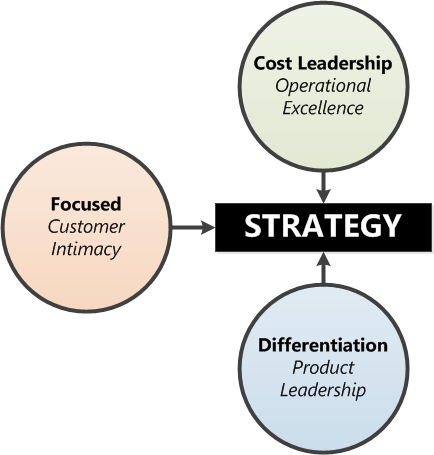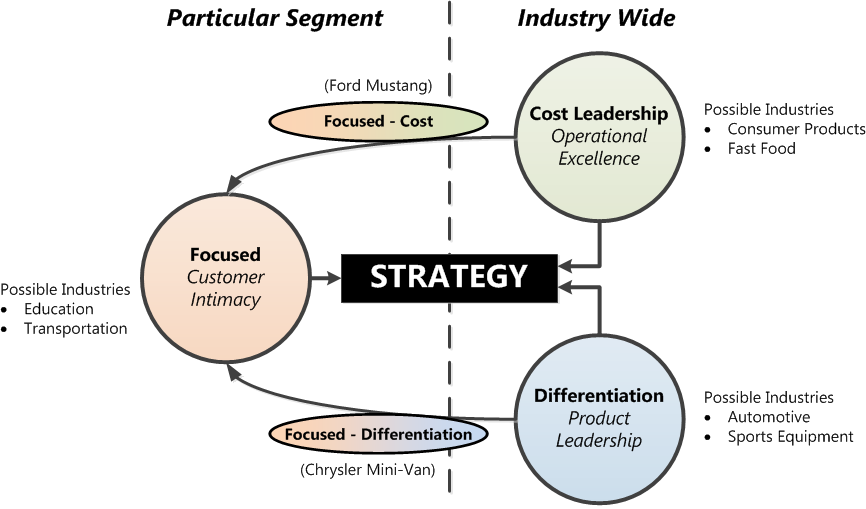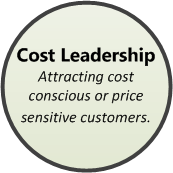
Introduction
There are three primary strategies available to an organization in order to achieve competitive advantage: Cost Leadership, Differentiation, and Focused.
- Cost Leadership: With Cost Leadership, an organization attempts to become the low cost producer in its industry. They must discover all sources of cost advantage.
- Differentiation: With Differentiation, an organization attempts to be unique in its industry while remaining valued by customers. They must discover and exploit unique products or product attributes that are perceived as important.
- Focused: With Focused, an organization attempts to choose specific customer target group(s) and develops its strategy to serving them to the exclusion of others. This target group will generally represent a small specific section of the industry-wide group.
Reference: Michael Porter The Competitive Advantage: Creating and Sustaining Superior Performance.
Primary Strategies
By choosing Cost Leadership as your primary strategic direction, market share is acquired by attracting cost-conscious or price-sensitive customers. The organization must offer the lowest price or best value.
Areas of challenge include:
- Achieving a high asset turnover
- Control over the complete value chain encompassing
- Inbound logistics
- Operations
- Outbound logistics
- Service
- Marketing & Sales
Maintaining this strategy requires a continuous search for cost reductions in all aspects of the business.
Cost Leadership is generally reserved for large firms with the opportunity to enjoy economies of scale. However, Cost Leadership can be a viable secondary strategy for small business where Focused is the primary strategy.
By choosing (product) Differentiation as your primary strategic direction, market share is acquired by differentiating a product or service to compete successfully in ways that are difficult to copy.
Areas of challenge include:
- Strong investment in research and development
- Maintaining unique resources and capabilities
- Identifying and mitigating risk
- Control over areas encompassing
- Marketing
- Purchasing
- Operations
- Human resources
Maintaining this strategy requires a continuous search for product and service improvements.
A Differentiation strategy is appropriate where the target customer is not price-sensitive and the market is competitive or saturated.
By choosing Focused as your primary strategic direction, market share is acquired by identifying the special needs of the customer and creating a strong relationship with the customer.
The Focused strategy has two variations:
- "Focused Cost": Here the organization seeks a low cost advantage within a particular customer segment as opposed to an industry wide group.
- "Focused Differentiation": Here the organization seeks a product differentiation advantage within a particular customer segment as opposed to an industry wide group.
Why your primary strategy selection is important
Each of the three primary strategies requires a different emphasis on critical success factors. For example:
- Cost leadership emphasizes process excellence.
- Differentiation emphasizes product excellence.
- Focused emphasizes relationship excellence.
Some examples of each would be:
- Cost leadership - Walmart consistently redesigns and improves value chain processes to keep costs low.
- Differentiation - Apple, introduced the iPod, iPhone, and iPad, when no similar consumer electronics products existed.
- Focused - Disney, builds everything around an audience and keeps driving channel leverage, finding more and more things to sell to that audience.
It has been said that there are only three things you can sell:
- What you have.
- What your customer should want.
- What your customer does want.
Cost Leadership sells what you have (and gets and distributes it as efficiently and effectively as possible).
Differentiation sells what your customer should want.
Focused sells what your customer does want.
Market Scope
Your strategy framework begins with defining both the primary strategy and the scope of your goal(s). A strong relationship exists between the primary strategy and the scope of your goal(s). At the highest level, scope is divided into two areas:
- Industry wide
- Particular segment
For example, the automotive industry is made up of many segments such as sports cars, family cars, luxury cars, exotic cars, etc. It can also include such segments as body work, tires, transmissions, mufflers, etc. A particular segment maybe identified by the targeted customer profile and their product needs. For example, in Lee Iacocca's first book he talked about building the Mustang at Ford and the minivan at Chrysler. Both involved the automotive industry but Ford and Chrysler were addressing vastly different market segments. In the case of the Mustang, they were selling to a younger crowd who wanted a sports car but couldn't afford a Corvette. In the case of the minivan, market research suggested that mothers wanted something new and different; a vehicle that could carry more people or cargo but not too high off the ground. In both cases everything, including the marketing plans, were driven by the customer profile.

Figure 2: Segment-Industry relationship
The segment - industry relationship
This is where we ad a twist to the three primary strategies and take a closer look at two variants of the strategies.
- Focused-Cost
- Focused-Differentiation
The terms Focused-Cost and Focused-Differentiation can be a little confusing. Focused-Cost means emphasizing cost-minimization for a focused market, and Focused-Differentiation means developing a differentiating product for a focused market. Remember the Mustang was for a younger customer profile who could not afford a Corvette (Focused-Cost) and the minivan was for people who wanted something new and different; a vehicle that could carry more people or cargo but not too high off the ground (Focused-Differentiation). Both organizations knew that no soccer mom would by a Mustang and no young unmarried man would by a minivan. See figure 2: Segment - industry relationship.
Choosing your primary strategy
It's now time to revisit a few of your earlier answers to the questions asked in Step 1: External Analysis.
Vision & Mission
- Do your vision and mission statements clearly articulate a specific segment of an industry?
Customer target segment
- Does your customer target segment narrow in on a specific demographic or persona of your prospective customer?
Threat of New Entrants to the Market
- Would it be easy for another organization to enter the market and compete directly with you?
Bargaining Power of Suppliers
- Does your supply-line allow for alternative or cheaper products?
Bargaining Power of Customers
- Would your prospective likely to shop for the best price for similar products?
Threat of Substitute Products
- Does your competitors offer similar products at the same or lower price?
Degree of Competitive Rivalry
- Would you suggest that your competition could be intense?
Choosing your primary strategy
By now you should have a good understanding of your business and your customer as they apply to your vision and mission. You can now complete Strategy Formulation step 3 and select your most appropriate primary strategy from the options below.





